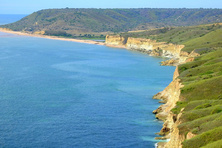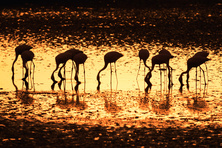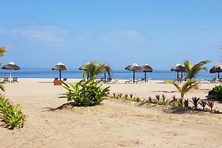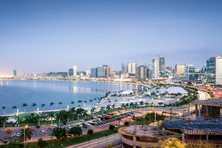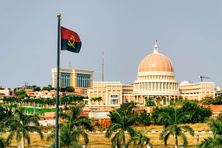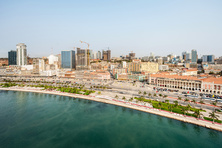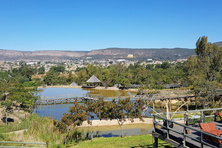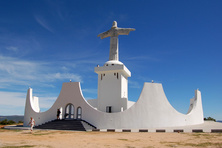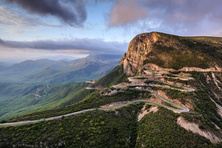Angola
- Currency: Angolan kwanza
- Time: UTC+1
- Languages: Portuguese language
- Religions: Christianity (Catholicism, Protestantism)
- Sections: Get in Visa Customs Cuisine Money Details of interest Popular resorts
Angola or officially known the Republic of Angola is a state in Africa. It borders Namibia, the Democratic Republic of Congo, and Zambia. The Cabinda Enclave shares its border with the Republic of the Congo. The country is washed by the waters of the Atlantic Ocean. The capital city is Luanda.
In the coastal lowland, the climate is tropical with frequent trade winds, on the plateau, the climate is monsoon equatorial with a long and wet summer which lasts from October to May and dry winter.
The official language is Portuguese. People also speak to the African languages. The majority of the population are the Catholics (57%) and over 30% are the Protestants.
In Angola, the tourists can go to safari and enjoy wonderful landscapes and see historical and architectural monuments of the colonial period.
The resorts Lobito, Benguela, and Soyo offer everything you need for a good fishing. You will also enjoy the beaches here.
In the Namibe Province, there is the Iona National Park.
Gabela is known for its unique nature. Some animals and plants can be found only in this place. The tourists can take a trip to the waterfalls and hot springs.
The lovers of historical and architectural monuments should visit the capital city of Luanda, Andulo, Cazombo, M’banza-Kongo, and Luau.
The diamond fields near Cafunfo and Cuango-Luzamba are known all over the world.
In Lubango, the tourists can see the statue of the Christ in a picturesque valley. This statue is an exact copy of the statue in Rio de Janeiro.
In the Malanje Province, the travellers will see the second largest waterfall in Africa Kalandula and unique natural formations Pedras Negras (Black Stones).
The Huambo Province is the main destination for those who loves trekking. They can enjoy the wonderful view from the Moco Mount.
Get in
By Plane
There are no direct flights from CIS countries to Angola. The citizens of these countries have to take a transit flight. A transfer can be made in one of the European airports or in Africa.
Many European airlines offer flights to Luanda. There are flights from London, Paris, Brussels, Madrid, Frankfurt, and Lisbon.
In Africa, there are flights to Luanda from South Africa, Namibia, Zimbabwe, the Democratic Republic of the Congo, and Kenya.
By Land
Angola has transport links with the neighbouring countries. A car is a convenient means of travelling if the tourists want to visit several countries.
By Sea
You can get to Angola by sea on a cruise ship. It suits those tourists who have a lot of time and want to combine travelling and transfer.
Visa
It is necessary for all the tourists of CIS countries and Europe to obtain a visa at the Embassy of Angola or in a visa centre. A visa gives you a permit to stay in the country for 30 days. Visa also required for a transit visit.
You can submit the documents personally, through a trusted person or a travel agency.
It usually takes from two to five working days to get a visa.
A visa is valid for 60 days from the date of issue.
Customs
It is allowed to import foreign currency without any restrictions, but the money must be declared.
The tourists can bring in the following goods duty-free:
- some alcohol and tobacco;
- food for personal use;
- personal belongings.
If the tourists bring in video and audio equipment and gadgets which they owe for less than a year, they have to provide a sales receipt with the date of the purchase.
If you have a return ticket, once a year you will be allowed to export foreign currency in the sum of 10.000 kwanzas (AOA). In other cases, the tourists should have a confirmation letter from the National Bank of Angola. If you spent some money and you export the sum less than indicated on the declaration form, it is necessary to provide the documents (sales receipts) confirming the costs.
The tourists are not allowed to export:
- national currency;
- unprocessed gem stones;
- crafts made of ivory;
- turtle shell;
- clams.
Cuisine
The cuisine of Angola was under a great influence of Portuguese cuisine, but still preserved its own local cooking traditions. As a result, in Angola one can try very unusual dishes. The staple food here is seafood, beans, and rice.
The tourists should try Kabula (a mix of dried and fresh meat) or goat with rice Caldeirada de Cabrito.
The foodies will enjoy the taste of chicken with palm oil sauce Muamba De Galinha.
People in Angola like soups with smoked chicken breast, fish or seafood.
The tourists will have a chance to try grilled seafood with a hot sauce Piri-piri and a fish dish Mufete de Cacuso.
At the end of the meal, treat yourself to Amarella, peanut sweets Doce-de-ginguba or coconut pudding.
The traditional beverage in Angola is Kussangua made from maize flour.
Do not miss a chance to try excellent locally produced wine and beer. Experience a new taste of palm nut beer Mongozo.
Money
The official currency is Kwanza (AOA). One kwanza is 100 centimos. The bank notes from 1 to 2.000 kwanzas and 1, 2, 5 kwanza coins are in circulation.
In Angola, the tourists can pay with US dollars. They are willingly accepted almost everywhere.
One can exchange the currency in any large hotel, a store or at a bank in Luanda. In the capital city, one can take advantage of the services of the street money changers who have a state license.
Traveller’s checks and credit cards are accepted in many large hotels, some restaurants, and shops in Luanda. In other cities, the checks are not accepted. Although, there are ATMs in any city, they do not accept foreign cards.
We do not recommend carrying large sums of money and jewellery. Be aware that the territory of the country has been cleared of mines after a recent conflict so when you go on safari, be very careful and do not move away from the route.
Details of interest
Sightseeing in Angola
The tourists remember Angola and its amazing landscapes. However, this country also has some UNESCO candidate sites which can be interesting for the tourists.
- The Church of Nossa Senhora da Conceicao in the Bengo Province.
- In the Kwanza Norte Province, the lovers of historical and architectural monuments can see the Church of Nossa Senora-de-Victoria and the Church of Nossa Senhora Rosario Cambambe, the Kamambe fortress, and Massango fortress.
- In Luanda, there are the Miguel Fortress and the Fortress of San Pedro de Barra.
- The Fort Kikombo is in the Province Kikombo.
- In M’banza-Kongo, anyone can see the ruins of the Colonial period.
In Angola, there are much more interesting places.
- The Kissama Park became a centre of safari, natural reserves and parks.
- Kalandula waterfall is one of the largest in Africa. It looks really impressive during the wet season.
- A mountain range Serra da Leba is an ideal place for those who love trekking.
- The Black Rock at Pungo Andongo is a solidified volcanic lava. This is a truly exotic place.
- In the Namibe Province, there is a famous desert with the same name. Here, there is a unique place where the ocean, Savannah and the desert meet. Such a rare combination creates unique landscapes and atmosphere. This is a good place for hunting, walking in the reserves and natural parks.
- The Cameo National Park can boast of a great variety of natural zones. On the territory of the park, you can see the lakes, Savannah, bottomland meadows of the Zambezi river, and a forest. This is a habitat for a huge number of various animals.
- The National Anthropology Museum and the Dondo Museum are in the capital city. The expositions include historical and ethnographic collections.
Souvenirs in Angola
In Angola, the tourists usually buy:
- ceremonial masks;
- wood, ivory, ceramic, bronze or stone figurines;
- things made of locally produced textile;
- pottery;
- spices;
- malachite souvenirs;
- tribal costumes.







